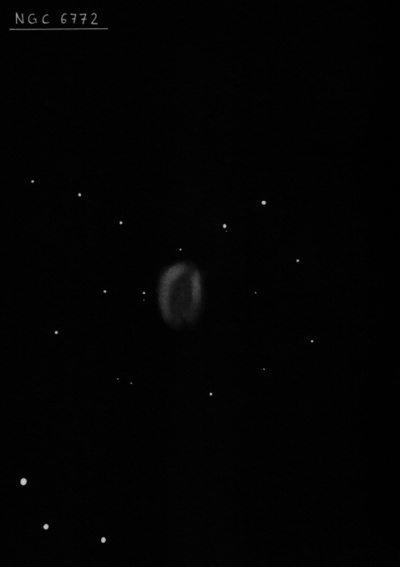
William Herschel discovered NGC 6772 = H IV-14 = h2032 on 21 Jul 1784 (sweep 242) and recorded "vF, r, nearly of equal light throughout; about 1' in diam. In the midst of numberless stars of the milky way." His position was 7' too far west-northwest. On 23 Jul 1827, JH noted "vF; R; vlbM; r; 30"." His position (also measured the next sweep) is fairly accurate.
Based on Crossley photographs at Lick, Curtis (1918) reported "the nebula is a a very faint and vague oval ring 75"x56" in p.a. about 173°. Brightest on the east and west edges; considerably fainter along and at the ends of the major axis."
200/250mm - 8" (7/31/81): faint, diffuse, moderately large.
300/350mm - 13.1" (8/8/86): moderately bright, slightly elongated N-S, estimate V = 13.0. Pretty view at 214x and UHC filter with a slightly mottled or uneven surface brightness.
400/500mm - 17.5" (9/5/99): easily picked up at 100x as a 1' disc, appearing slightly irregular. Best view at 220x and 280x using a UHC filter. The disc was quite irregular in surface brightness and slightly elongated N-S. Most notably, the rim is generally brighter along the northern side in a broad "U" shape with the center weakly annular. The south rim of the planetary is fainter and less well defined. No central star seen at 380x.
600/800mm - 24" (8/30/16): at 225x and 375x (unfiltered); moderately bright and large, slightly elongated ~N-S, ~70"x55". The rim is slightly brighter, particularly along the east and west side and weaker on the south end. The surface brightness is irregular or mottled and there appeared to be a small knot [the DSS reveals two faint, very close stars] embedded on the northeast side. A mag 15.7 star is just off the east side [44" from center] and a mag 16.3 star is just off the north end [52" from center].
Notes by Steve Gottlieb